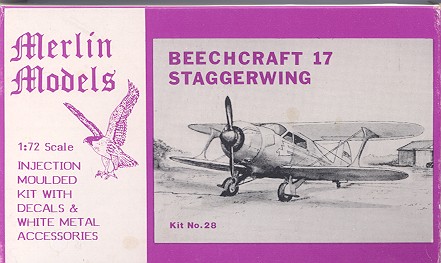
| KIT: | Merlin 1/72 Beechcraft 17 Staggerwing |
| KIT #: | 28 |
| PRICE: | $Too much at any price |
| DECALS: | Two options |
| REVIEWER: | Joel Hamm |
| NOTES: | Company long defunct. Alternate kit - Sword 72010 |

| HISTORY |
Preview # 3 Kits From Hell
The preview of Meikraft’s kit covered the Beech’s history. Brief recap: Despite being built during the Great Depression, it was a luxurious, high performance personal transport that was scarfed up by the US Army, Navy, and allies as a communications plane and big-wig limousine.
| THE KIT |
 By my recollection, Merlin Models in Britain was the first of the cottage
industry producers, startling, in a minor way, the modeling world with a
selection of historically significant subjects the major companies could
never be expected to tackle. All of their offerings came squished in a
diminutive end-opening El-Cheapo carton with monochrome graphics and only a
pencil drawing as box art.
By my recollection, Merlin Models in Britain was the first of the cottage
industry producers, startling, in a minor way, the modeling world with a
selection of historically significant subjects the major companies could
never be expected to tackle. All of their offerings came squished in a
diminutive end-opening El-Cheapo carton with monochrome graphics and only a
pencil drawing as box art.
Having just previewed Meikraft’s Beechcraft kit, I was struck by the similarities. I’m not making any accusations (particularly not of the Dearly Departed), but it would not have been below those pioneers to do a bit of pirating. The cabin floorboards and instrument panels are alike beyond coincidence. Airframe parts are almost identical in breakdown and engineering; particularly in the molding of a ponderous paunch of cabin belly to the lower wing; and the representation of wheel wells as shallow depressions. Some differences are evident. Meikraft opens the windshield and side window apertures, offering vacu-ed transparencies. Merlin molds the see-through stuff integral with the clear fuselage sections. “Clear” is misleadingly generous. “Transparent” and even “translucent” also hide the truth. “Nonpigmented styrene” gives the prospective builder the best clue of how much polishing he will have to put in if he expects any interior furnishings to be visible.
Quality differences also separate the two renderings. Merlin’s wings and tailplanes are over-cambered and suffer a noticeable wiggle factor in some trailing edges; while Meikraft’s are properly thin and straight. The former, though managed to achieve sharply defined scribing and rivets with a smooth surface, as opposed to the latter’s grainy and acne-ed skin.
All Merlin’s small parts are cast in white metal, which was the precursor of resin, and are rough to the point of being useless. Equally useless is the instruction sheet. I quote: “…Glue fuselage halves together taking care not to get any excess cement onto cabin windows…Cement lower wing assembly into place beneath the fuselage…Add Wing struts, leave to dry out thoroughly. Glue the two top wings into place. Cement all tail units onto fuselage…Rig completed model.” Get the picture? A picture is precisely what is not provided. No exploded view. 3 view line drawings at least are 1/72 scale so measurements can be matched to the model. Under decals I said “presumably” 2 A/C, because those line drawings show an Army and a civil plane. I found no decals in the box; and it’s unlikely I had midnight requisitioned them for another project. Merelin’s decals were always on par with early Airfix.
| CONCLUSIONS |
Another clear case of Barely Buildable But Why Bother. While they are still available, get the Sword Staggerwing on either wheels or floats.
January 2006
If you would like your product reviewed fairly and quickly by a site that has over 300,000 visitors a month, please contact me or see other details in the Note to Contributors.